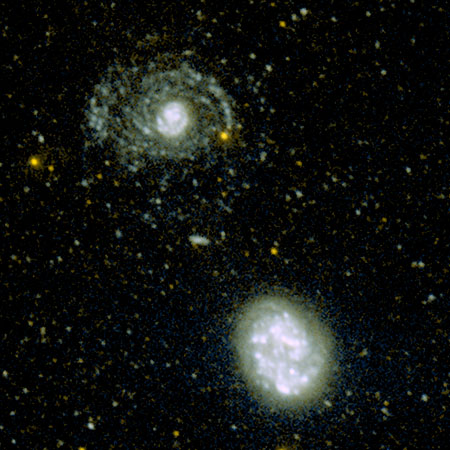Post
by Ann » Thu Feb 16, 2012 4:50 pm
It is interesting to consider today's galaxies, NGC 5965 and NGC 5963.
The edge-on yellow galaxy, NGC 5965, is well-formed, although its disk is slightly "undulating". This is probably more the rule than the exception for disk galaxies, at least for spiral galaxies. Note that NGC 5965 is almost certainly interacting with the small yellow galaxy to the right of it.
NGC 5965 has an extensive yellow bulge. It has a very obvious dust lane and several sets of dust rings(?) in its disk. Its outer edges are blue. Both the color gradient and the general shape of NGC 5965 reminds me of the Andromeda Galaxy, although NGC 5965 is clearly bigger.
It is interesting to compare the blue magnitude of NGC 5965 with the far infrared magnitude of this galaxy. Two things may be noted here. Galaxies which are seen edge-on are often a little extra bright in far infrared light. That is because they present their dustiest aspect to us, and far infrared light typically traces warm dust. Since NGC 5965 is seen almost edge on, flaunting its dust lane at us, it ought to be fairly bright in far infrared light just because of that.
The other thing to remember about far infrared light is that it typically traces star formation, too. Star formation warms the dust and makes it emit a lot of far infrared light.
Spiral galaxies that are "middle of the road", neither rich nor poor in dust and star formation, are typically about equally bright in blue light and in far infrared light. So what about NGC 5965?
Fascinatingly, edge-on NGC 5965 with its prominent dust lane is comparatively faint in far infrared light. It is about 0.8 magnitudes fainter in far infrared light than in blue light. There can't be a lot of star formation going on in that galaxy.
What about NGC 5963? It is seen almost face on, and there is very little visible dust in it. Yet this blue galaxy is about 0.8 magnitudes brighter in far infrared light than in blue light!
There is a reason why NGC 5963 is blue. It may be faint, but it is dominated by young stars. And there is a good deal of star formation going on inside it.
Ann
Color Commentator
 NGC 5965 and NGC 5963 in Draco
NGC 5965 and NGC 5963 in Draco
